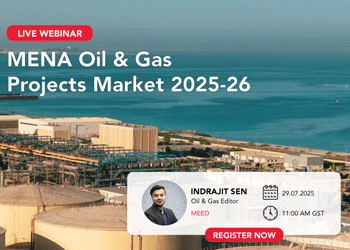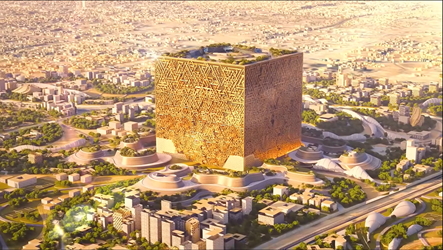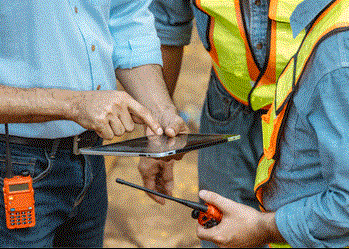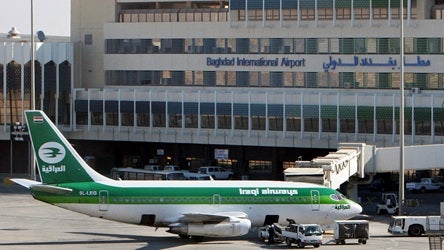Saudi Arabia launches 200 PPP projects
6 April 2023
Saudi Arabia has announced a Privatisation & PPP (P&PPP) pipeline that includes 200 projects across 17 sectors.
This new P&PPP pipeline aims to attract local and international investors and ensure their readiness to participate in the schemes tendered to the market.
The initiative comes as the kingdom strives to increase the attractiveness of its economy and raise the private sector's contribution to GDP.
Minister of Finance and chairman of the Board of the National Centre for Privatisation & PPP (NCP), Mohammed al-Jadaan, said the list of projects aligns with the aims of Vision 2030, reinforces the strength of public-private partnerships (PPPs) and will contribute to attracting new international investments.
The pipeline of projects for each sector will be available for investors through the NCP portal.
Information about the first 140 projects has already been published, and more projects are expected soon.
Four PPP airports projects
In line with Saudi Arabia's aviation strategy to increase the country’s annual passenger handling capacity to 330 million by 2030, the kingdom has announced plans to tender four airports under the P&PPP pipeline: Abha International airport, Taif International airport, Hail International airport and Prince Naif International airport in Al-Qassim.
The Ministry of Transport & Logistics Services will procure the schemes.
The launch dates for the PPP tenders were not specified. However, MEED reported in July 2022 that through NCP, Saudi Arabia’s Matarat Holding Company was expected to start the procurement process to develop airport PPP projects in 2023.
In the initial plan, the Abha and Taif airport PPPs were scheduled to be tendered in the first half of 2023, while the Hail and Qassim airport projects were to be potentially tendered in the second half of 2023.
The P&PPP pipeline list includes:
Abha International airport
The existing Abha International airport is operating above capacity with 4.4 million passengers annually against the originally designed capacity of 1.5 million. The targeted capacity for the new airport is 8.5 million passengers a year by 2030 and 13 million passengers by 2053. The contract type is the build-transfer-operate (BTO) model and the project duration is 30 years.
Taif International airport
The capacity of the current Taif International airport is 600,000 passengers. The targeted capacity of the new airport is 4 million passengers by 2030 and 7.4 million passengers by 2053. The project will be developed under the design-build-finance-operate-maintain (DBFOM) concession; its duration is 30 years.
Hail International airport
This project aims to develop the airport and service facilities following the standards approved by the International Civil Aviation Organisation (ICAO). The targeted airport capacity increase is 3 million passengers a year. The contract type, duration and launch details are not specified.
Prince Naif International airport in Al-Qassim
The scheme involves developing the airport in Al-Qassim in line with ICAO standards and increasing its capacity to 5.3 million passengers annually. The contract type, duration and launch details are not specified.
The Taif, Hail and Al-Qassim airport schemes were previously tendered and awarded as PPP projects using a BTO model.
Saudi Arabia’s General Authority of Civil Aviation (Gaca) awarded the contracts to develop four airport PPP projects to two consortiums in 2017. A team of Tukey’s TAV Airports and the local Al-Rajhi Holding Group won the 30-year concession agreement to build, transfer and operate airport passenger terminals in Yanbu, Qassim and Hail.
A second team, comprising Lebanon’s Consolidated Contractors Company, Germany’s Munich Airport International and local firm Asyad Group, won the BTO contract to develop Taif International airport.
These projects then stalled following the restructuring of the kingdom’s aviation sector.
Saudi Arabia has already privatised airports including the $1.2bn Prince Mohammed bin Abdulaziz International airport in Medina, which was developed as a PPP and opened in 2015.
Four PPP highways schemes
The kingdom has also announced plans to tender four highway schemes under the P&PPP pipeline. The following schemes will be procured by the Ministry of Transport & Logistic Services:
- The 136-kilometre Asir-Jizan highway will include six intersections, 18km of bridges and a 9km-long tunnel network. The project starts at Al-Farah in Asir and extends to the Red Sea through Jizan. The contract type is DFBOM, and the project duration is 30 years. The launch date is not specified.
- The 570km Jeddah-Jizan highway will comprise 43 intersections, 11 wildlife crossings and 29 bridges. The project scope includes converting the current 280km of double lanes into three lanes. The contract model is not specified; the project duration is 30 years.
- The 447km Yanbu-Jubail highway will contain 17 intersections, 14 wildlife crossings, four bridges, one tunnel and 18 service areas. Construction work on a 39km section towards the Al-Zulfi area has been completed. The contract model, duration and launch date are not specified.
- The Jeddah-Makkah road spans a length of 64km. It consists of seven interchanges and four camel crossings. The construction is under way for 51km of the road and is being carried out in three phases. The construction works for phase four are yet to begin. The construction cost for phase four of the road will be funded by the government, similar to the ongoing construction works for phases one to three. The proposed scope of work is for the operation and maintenance of the Jeddah-Makkah road, and developing and operating motorway service areas. The contract's duration and the tender's launch date are not specified.
Other planned PPP projects
Saudi Arabia has also announced plans to tender seven PPP desalination projects.
The independent water projects (IWPs) represent an aggregate desalination capacity of 2.8 million cubic metres a day (cm/d). Owned by the Ministry of Environment, Water & Agriculture, the IWPs will be procured under 25-year build-own-operate (BOO) contracts.
The first project, Ras al-Khair 2 with a capacity of 600,000 cm/d, will be launched in February 2024.
This will be followed by the launch of another IWP, the 400,000 cm/d Ras al-Khair 3, in April 2024.
In March 2025, the kingdom plans to launch the Tabuk IWP with a capacity of 400,000 cm/d. The Alshuqaiq 4 IWP is set for launch in July 2025, with a capacity of 400,000 cm/d.
These schemes will be followed by the Rabigh 5 IWP, with a capacity of 400,000 cm/d, to be launched in April 2027, and the Rayis 2 IWP, with a capacity of 300,000 cm/d, set for launch in July 2035.
Finally, the Jizan IWP is set to have a capacity of 300,000 cm/d. Its launch date is not yet disclosed.
In addition, the kingdom plans to tender six wastewater treatment projects starting in 2024. The five independent sewage treatment plants (ISTPs), one small sewage treatment plant (SSTP) and collection network will treat wastewater for reuse in non-agricultural municipal and industrial applications.
The five ISTPs represent an aggregate wastewater treatment capacity of 650,000 cm/d.
The Ministry of Environment, Water & Agriculture will procure the projects under build-own-operate-transfer (BOOT) models.
Other projects to be tendered under the P&PPP pipeline include several medical centres, health centres, hospitals, educational buildings, schools, colleges, universities, strategic water reservoirs, marine services schemes, land ports and power stations.
Exclusive from Meed
-
 WEBINAR: Mena Oil & Gas Projects Market 2025-26
WEBINAR: Mena Oil & Gas Projects Market 2025-2610 July 2025
-

-
 Chinese firm wins Mid Island Parkway tunnelling deal
Chinese firm wins Mid Island Parkway tunnelling deal10 July 2025
-
 Iraq tenders Baghdad airport PPP project
Iraq tenders Baghdad airport PPP project9 July 2025
-

All of this is only 1% of what MEED.com has to offer
Subscribe now and unlock all the 153,671 articles on MEED.com
- All the latest news, data, and market intelligence across MENA at your fingerprints
- First-hand updates and inside information on projects, clients and competitors that matter to you
- 20 years' archive of information, data, and news for you to access at your convenience
- Strategize to succeed and minimise risks with timely analysis of current and future market trends

Related Articles
-
 WEBINAR: Mena Oil & Gas Projects Market 2025-26
WEBINAR: Mena Oil & Gas Projects Market 2025-2610 July 2025
Date & Time: Tuesday 29 July 2025 | 11:00 AM GST
Agenda:
1. Summary of the Mena oil, gas and petrochemicals projects market
2. Summary description of the main megaprojects, including project programmes
3. Analysis of active contracts and spending to date
4. Analysis of top contracts by work already awarded
5. Long-term capital expenditure outlays and forecasts
6. Highlights of key contracts to be tendered and awarded over the next 18 months
7. Top contractors and clients
8. Breakdown of spending by segment, ie, oil, gas, petrochemicals – upstream, downstream, onshore and offshore
9. Q&A session
https://image.digitalinsightresearch.in/uploads/NewsArticle/14241705/main.gif -
 New Murabba signs up South Korean firm for design works
New Murabba signs up South Korean firm for design works10 July 2025
Register for MEED’s 14-day trial access
Saudi Arabia’s New Murabba Development Company (NMDC) has signed a memorandum of understanding (MoU) with South Korea’s Heerim Architects & Planners to explore further design works on assets at the 14 square-kilometre New Murabba downtown project.
According to an official statement: “Heerim Architects & Planners will explore distinctive architectural plans that complement the development’s masterplan, with special focus on anchor assets, linear parks and smart city features.”
New Murabba CEO Michael Dyke signed the agreement last week during the company’s Investment and Partnership Forum in Seoul.
At the event, NMDC also signed an MoU with South Korea’s Naver Cloud Corporation to explore technological solutions for delivering the New Murabba downtown project.
According to an official statement: “The three-year agreement covers exploring innovative technology and automation to support the delivery of New Murabba, including robotics, autonomous vehicles, a smart city platform and digital solutions for monitoring construction progress.”
NMDC is in Seoul to examine technological offerings, assess financing options and showcase the investment opportunities available for the New Murabba downtown development.
The statement added that the excavation works for The Mukaab, the centrepiece of the overall development, have now been completed.
The Mukaab is a Najdi-inspired landmark that will be one of the largest buildings in the world. It will be 400 metres high, 400 metres wide and 400 metres long. Internally, it will have a tower on top of a spiral base and a structure featuring 2 million square metres (sq m) of floor space designated for hospitality. It will feature commercial spaces, cultural and tourist attractions, residential and hotel units, and recreational facilities.
Downtown destination
The New Murabba destination will have a total floor area of more than 25 million sq m and feature more than 104,000 residential units, 9,000 hotel rooms and over 980,000 sq m of retail space.
The scheme will include 1.4 million sq m of office space, 620,000 sq m of leisure facilities and 1.8 million sq m of space dedicated to community facilities.
The project will be developed around the concept of sustainability and will include green spaces and walking and cycling paths to promote active lifestyles and community activities.
The living, working and entertainment facilities will be developed within a 15-minute walking radius. The area will use an internal transport system and will be about a 20-minute drive from the airport.
The downtown area will feature a museum, a technology and design university, an immersive, multipurpose theatre, and more than 80 entertainment and cultural venues.
 READ THE JULY 2025 MEED BUSINESS REVIEW – click here to view PDF
READ THE JULY 2025 MEED BUSINESS REVIEW – click here to view PDFUAE and Turkiye expand business links; Renewed hope lies on the horizon for trouble-beset Levant region; Gulf real estate momentum continues even as concerns emerge
Distributed to senior decision-makers in the region and around the world, the July 2025 edition of MEED Business Review includes:
> AGENDA: UAE-Turkiye trade gains momentum> INTERVIEW 1: Building on UAE-Turkiye trade> INTERVIEW 2: Turkiye's Kalyon goes global> INTERVIEW 3: Strengthening UAE-Turkiye financial links> INTERVIEW 4: Turkish Airlines plans further growth> CURRENT AFFAIRS: Middle East tensions could reduce gas investments> GCC REAL ESTATE: Gulf real estate faces a more nuanced reality> PROJECTS MARKET: GCC projects market collapses> INTERVIEW 5: Hassan Allam eyes role in Saudi Arabia’s transformation> INTERVIEW 6: Aseer region seeks new investments for Saudi Arabia> LEADERSHIP: Nuclear power makes a global comeback> LEVANT MARKET FOCUS: Levant states wrestle regional pressures> GULF PROJECTS INDEX: Gulf projects index continues climb> CONTRACT AWARDS: Mena contract award activity remains subdued> ECONOMIC DATA: Data drives regional projects> OPINION: A farcical tragedy that no one can endTo see previous issues of MEED Business Review, please click herehttps://image.digitalinsightresearch.in/uploads/NewsArticle/14239016/main.jpg -
 Chinese firm wins Mid Island Parkway tunnelling deal
Chinese firm wins Mid Island Parkway tunnelling deal10 July 2025

Register for MEED’s 14-day trial access
Beijing-headquartered China Railway Tunnel Engineering Group has won a $60m subcontract for the tunnelling works on package 1B of the Mid Island Parkway project in Abu Dhabi.
Package 1B entails the construction of a cut-and-cover tunnel to cross the Khor Laffan Channel, which is the area between the Saadiyat and Um-Yifeenah islands.
The tunnel, which will be between 900 metres and 1 kilometre (km) long, is being constructed on a design-and-build basis and will tie in to packages 1A and 1C.
The project is being jointly constructed by a joint venture of local firm Yas Projects (Alpha Dhabi Holding) and Beijing-based China Railway International Group.
In June last year, MEED exclusively reported that Abu Dhabi's Department of Municipality & Transport had awarded contracts for three packages for phase one of the Mid Island Parkway Project (MIPP), as part of the Plan Capital urban evolution programme.
Phase one will start at the existing Saadiyat Interchange, which will connect the E12 road to the MIPP, and will end with the recently constructed Um-Yifeenah Highway.
It comprises a dual main road with a total length of 8km, including four traffic lanes in each direction, two interchanges, a tunnel and associated infrastructure works.
MIPP phase one is further divided into packages 1A, 1B and 1C, which were awarded separately.
The project ownership has been transferred from Aldar Properties to Abu Dhaibi's Department of Municipalities & Transport.
Previously, it was transferred from Abu Dhabi General Services Company (Musanada) to Aldar Properties, and the project was included in the Abu Dhabi Investment Office's public-private partnership project pipeline.
 READ THE JULY 2025 MEED BUSINESS REVIEW – click here to view PDF
READ THE JULY 2025 MEED BUSINESS REVIEW – click here to view PDFUAE and Turkiye expand business links; Renewed hope lies on the horizon for trouble-beset Levant region; Gulf real estate momentum continues even as concerns emerge
Distributed to senior decision-makers in the region and around the world, the July 2025 edition of MEED Business Review includes:
> AGENDA: UAE-Turkiye trade gains momentum> INTERVIEW 1: Building on UAE-Turkiye trade> INTERVIEW 2: Turkiye's Kalyon goes global> INTERVIEW 3: Strengthening UAE-Turkiye financial links> INTERVIEW 4: Turkish Airlines plans further growth> CURRENT AFFAIRS: Middle East tensions could reduce gas investments> GCC REAL ESTATE: Gulf real estate faces a more nuanced reality> PROJECTS MARKET: GCC projects market collapses> INTERVIEW 5: Hassan Allam eyes role in Saudi Arabia’s transformation> INTERVIEW 6: Aseer region seeks new investments for Saudi Arabia> LEADERSHIP: Nuclear power makes a global comeback> LEVANT MARKET FOCUS: Levant states wrestle regional pressures> GULF PROJECTS INDEX: Gulf projects index continues climb> CONTRACT AWARDS: Mena contract award activity remains subdued> ECONOMIC DATA: Data drives regional projects> OPINION: A farcical tragedy that no one can endTo see previous issues of MEED Business Review, please click herehttps://image.digitalinsightresearch.in/uploads/NewsArticle/14238039/main3047.gif -
 Iraq tenders Baghdad airport PPP project
Iraq tenders Baghdad airport PPP project9 July 2025
Register for MEED’s 14-day trial access
Iraq’s Ministry of Transport and the General Company for Airport & Air Navigation Services have released a tender inviting firms to bid for a contract to develop Baghdad International airport on a public-private partnership (PPP) basis.
The notice was issued in July, and the submission deadline is in September.
According to an official statement posted on its website, Iraq’s Ministry of Transport said that 10 out of 14 international consortiums that expressed interest in the project earlier this year have been prequalified to compete for the tender.
The scope of the estimated $400m-$600m project involves rehabilitating, expanding, financing, operating and maintaining the airport. It is the first airport PPP project to be launched in Iraq.
The initial capacity of the airport is expected to be around 9 million passengers, which will be gradually increased to 15 million passengers.
The International Finance Corporation (IFC), a member of the World Bank Group, is the project’s lead transaction adviser.
Iraq is already developing the Baghdad and Najaf-Karbala metro projects using a similar PPP model.
Earlier this month, MEED reported that Iraq intends to retender the contract to develop and operate the Baghdad Metro project, following the award of the estimated $2.5bn contract last year.
According to local media reports, Nasser Al-Assadi, adviser to Prime Minister Mohammed Sudani, stated that the previous developers had overestimated the project budget; therefore, the government will relaunch the entire process to implement the project.
https://image.digitalinsightresearch.in/uploads/NewsArticle/14229008/main.jpg -
 Contractors prepare revised bids for Roshn stadium
Contractors prepare revised bids for Roshn stadium9 July 2025

Register for MEED’s 14-day trial access
Saudi gigaproject developer Roshn has invited firms to submit revised commercial proposals by 24 July for a contract to build a new stadium adjacent to the National Guard facilities to the southwest of Riyadh.
Known as the National Guard Stadium, it will be delivered on an early contractor involvement (ECI) basis. It will cover an area of over 450,000 square metres and be able to accommodate 46,000 spectators.
The scope of work also covers the construction of auxiliary facilities, including training academy offices and two hotels, as well as retail and food and beverage outlets.
The firms had initially submitted bids on 8 April for the contract.
The stadium is scheduled to host 32 Fifa World Cup tournament games in 2034.
In August last year, MEED reported that Saudi Arabia plans to build 11 new stadiums as part of its bid to host the 2034 Fifa World Cup.
Eight stadiums will be located in Riyadh, four in Jeddah and one each in Al-Khobar, Abha and Neom.
The proposal outlines an additional 10 cities that will host training bases. These are Al-Baha, Jazan, Taif, Medina, Al-Ula, Umluj, Tabuk, Hail, Al-Ahsa and Buraidah.
The bid proposes 134 training sites across the kingdom, including 61 existing facilities and 73 new training venues.
The kingdom was officially selected to host the 2034 Fifa World Cup through an online convention of Fifa member associations at the Fifa congress on 11 December 2024.
 https://image.digitalinsightresearch.in/uploads/NewsArticle/14228507/main.jpg
https://image.digitalinsightresearch.in/uploads/NewsArticle/14228507/main.jpg

